Osteochondrosis is a widespread disease of the intervertebral discs that affects people of different age groups.Today, it is diagnosed in more than 40% of fairly young people under 35 years old, and among the older category it affects 9 out of 10 people. It has several stages of development, and the earlier the pathology is detected, the easier and more effective the treatment and the lower the risk of developing dangerous complications.
What is osteochondrosis
The intervertebral discs are located between the vertebral bodies and act as a kind of shock absorbers that absorb stress when walking or performing other physical activities.They have different sizes depending on their position: in the cervical region the discs are the smallest and in the lumbar spine they are the largest.
They are all built the same.In the center is the nucleus pulposus, which is the main component of the disc and has great elasticity.It is surrounded by a fibrous membrane and vertical plates.
Osteochondrosis is a degenerative-dystrophic disease in which there is a change in the shape and size of the intervertebral discs due to their abrasion and the prerequisites are created for the formation of hernias, deformation of the vertebral bodies, spondylosis and other disorders.
Thinning of the discs is a consequence of malnutrition of the cartilage tissue, which leads to a gradual decrease in its elasticity and increased fragility.
As a result, the discs change their position, their height decreases, and microcracks form on their fibrous membrane.This creates serious preconditions for the formation of intervertebral hernias, pinching of spinal roots or blood vessels.
The slightest changes in the state of the disks lead to a disruption in their functions.This is accompanied by pain of varying intensity.At the same time, prerequisites are created for the development of diseases of internal organs, since the quality of their activity directly depends on the state of the spine and the conductivity of bioelectric impulses along the nerves.
It can affect one or more intervertebral discs in any part of the spine.Therefore, osteochondrosis is diagnosed:
- cervical spine;
- thoracic spine;
- lumbar spine.
In particularly severe cases, the pathological process affects the majority of the intervertebral discs of the spine, which is accompanied by discomfort throughout the back and almost complete loss of performance.But most often osteochondrosis affects the lumbar spine, since it bears the greatest load, as well as the intervertebral discs of the cervical spine due to their high mobility.
Development
During osteochondrosis, we can roughly distinguish 4 stages:
- A decrease in the level of hydration of the disc, which leads to its dehydration and the formation of microcracks.Often at this stage there is still no manifestation of the incipient disease.
- A decrease in the height of the disc, which leads to the appearance of the first symptoms of pathology.At this stage, there is a decrease in the distance between individual segments, which leads to a decrease in the tone of the spinal ligaments and creates the possibility of moving the vertebrae from their natural positions, that is, the development of spondylolisthesis.In such situations, a wave-like course of the disease is most often observed.It allows you to distinguish between periods of exacerbation, accompanied by sharp pain, and periods of remission, during which there is no discomfort or aching pain.
- Deformation of the affected intervertebral disc with the formation of protrusion or prolapse.Sometimes the joints are involved in the pathological process, which is manifested by the development of arthrosis or vertebral subluxations.At this stage, the immune system responds to the processes occurring in the spine by developing aseptic inflammation with swelling of the tissues surrounding the affected spinomotor segment.In this case, pain occurs regularly, reflex muscle spasms as well as mobility limitations can be observed.In rare cases, signs of neurological deficit (radicular syndrome) already develop as a result of pinching of nerve fibers by the resulting protrusions of the intervertebral discs.
- Development of complications.Since the human body has broad compensatory capabilities, when the intervertebral disc loses its ability to perform its functions, the process of osteosynthesis is activated to maintain the vertebrae in a stable position.This leads to the formation of bony protrusions - osteophytes - at the edges of the vertebral bodies of the affected spinal movement segment.As a result, thanks to them, two or more vertebrae firmly fuse, forming a single conglomerate, that is, spondylosis develops.This always leads to pinched nerves and the development of acute neurological symptoms in the form of paresis, paralysis and serious disorders in the functioning of the corresponding internal organs.
Reasons
Today there are many theories about the development of osteochondrosis, including vascular, mechanical, hereditary, hormonal, infectious-allergic and others.But none of them is able to fully explain the mechanism of development of changes in the tissues of the intervertebral discs.Therefore, it is very likely that they all complement each other.
So, a large number of very diverse factors can lead to the development of osteochondrosis.Among them, the most significant are:
- genetic predisposition;
- regular performance of heavy physical work;
- maintain a sedentary lifestyle;
- the presence of scoliosis or other spinal deformities;
- suffering from back injuries;
- unbalanced diet, vitamin deficiency;
- infectious diseases;
- metabolic disorders;
- congenital anomalies of the spine (Kimerli anomaly, Chiari anomaly, craniovertebral anomalies, sacralization, lumbarization);
- overweight;
- intense and regular stress.
It is believed that the most significant influence on the condition of the intervertebral discs is the constant overload of a certain segment of movement of the spine.It can be not only hard and monotonous physical work, but also a constant bending position or the habit of sitting for a long time.In such situations, additional stress is placed on the discs, muscles and ligaments, and other factors only make the situation worse.
In general, osteochondrosis can be called an almost natural age-related disease, which is the inevitable price to pay for walking upright.
Symptoms
The first sign of the development of the disease is the appearance of a cracking sound in the part of the spine where the appearance of degenerative-dystrophic changes is observed.It is a consequence of the occurrence of disc nutrition disorders and the progression of its dehydration.At this stage, patients almost never see a doctor.Therefore, their daily routine, eating habits and other factors remain the same, which contributes to the worsening of the situation and the transition of the disease to the second stage.
As a result, typical symptoms of osteochondrosis begin to appear:
- severe muscle tension in the affected area on one or both sides of the spine;
- sharp, aching pains that intensify with each movement and gain intensity over time, becoming unbearable;
- numbness in the arms or legs;
- weakness;
- stiffness of movements, unauthorized limitation of mobility;
- decrease in muscle tone until complete atrophy;
- poor posture;
- increases in blood pressure.
As the pathology progresses, the signs of osteochondrosis worsen.80% of patients experience dull pain in the area of the affected spinal movement segment, also characteristic of myositis.
Osteochondrosis of the cervical spine
When the cervical spine is affected, pain tends to radiate to the shoulder girdle, arms and other manifestations of neurological disorders occur.Patients hold their heads in the least painful position and, if necessary, turn over with their whole body.
In addition, pathologies of organs innervated by the spinal cord region of the cervical spine may develop:
- tinnitus and diseases of the ENT organs;
- dizziness;
- blurred vision;
- migraines;
- levels of irritability and anxiety increase;
- sleep problems;
- increased risk of allergic reactions;
- decreased levels of thyroid hormones.
With osteochondrosis of the cervical spine, vertebral artery syndrome and vegetative-vascular dystonia are often additionally diagnosed.
Infection of the cervical spine with osteochondrosis, especially when complicated by intervertebral protrusions and hernias, can lead to pinching of blood vessels.This results in impaired blood supply to the brain, which can be accompanied by attacks of dizziness, loss of consciousness and even a stroke.
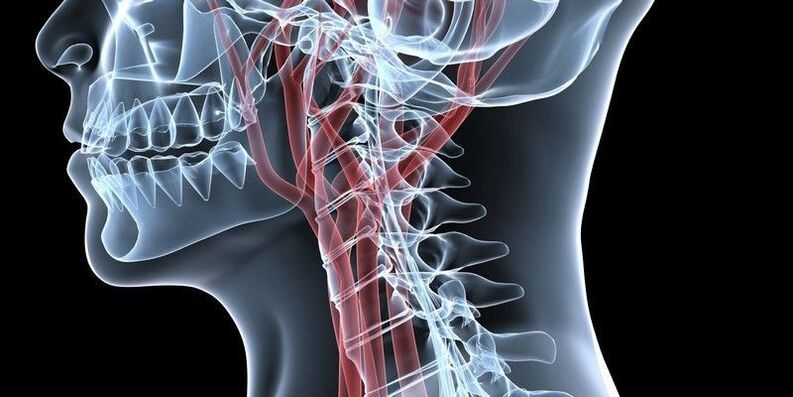
Osteochondrosis of the thoracic spine
With osteochondrosis of the thoracic region, which is diagnosed quite rarely, pain occurs in the spine in the area of the shoulder blades and can intensify even with deep breathing.They are often felt behind the breastbone, which can be confused with heart disease.
When the spinal roots are pinched, the risk of diseases of the internal organs increases, including:
- bronchi and lungs (asthma, bronchitis, pneumonia, pleurisy);
- gallbladder and its duct, liver (cholecystitis, jaundice, fat absorption disorders);
- pancreas and duodenum (digestive disorders, pain in the left hypochondrium);
- the adrenal glands, which affect the overall strength of the immune system and can cause the development of allergies;
- kidneys (urinary disorders, chronic pyelonephritis, glomerulonephritis, etc.);
- pelvic organs (digestive disorders, gynecological, urological diseases, infertility).
Fact: damage to the intervertebral disc of the 7th thoracic vertebra by osteochondrosis can lead to the development of diabetes mellitus.
Osteochondrosis of the lumbosacral spine
With osteochondrosis of the lumbar region, lumbago, called lumbago, is observed.This is accompanied by burning, unbearable pain that comes on suddenly.Often, patients even have difficulty sitting, standing and walking, which may indicate the development of radicular syndrome.In such situations, it is easy to notice how they sit down and get up slowly, trying as much as possible to avoid tilting their torso.
In case of complications, the main danger is pinching of the cauda equina nerves, as this can lead to impaired control of the emptying processes of the intestine and bladder, as well as paralysis of the legs.Also in such cases the following phenomena may develop:
- appendicitis;
- diarrhea, constipation;
- pain in the lower abdomen;
- bladder dysfunction;
- impotence;
- pain in knees, feet, hips, or groin;
- swelling of the legs.
Complications
Osteochondrosis is a possible cause of a large number of different diseases.Most often, if left untreated, it leads to the formation of a protrusion and intervertebral hernia.This in turn can cause:
- discogenic myelopathy, which ends with paresis, muscle atrophy, changes in tendon reflexes, loss of control over urination and defecation, and even paralysis of the limbs;
- radiculopathy;
- scoliosis or other spinal deformity;
- spinal cord infarction due to compression of the artery that supplies it;
- stroke due to compression of the occipital artery.
Diagnosis
The appearance of back and neck pain should be a reason to contact a neurologist or vertebrologist.The earlier osteochondrosis is diagnosed, the easier and more effective the treatment will be.
To diagnose the disease, the doctor questions and examines the patient.Based on their results, it is already possible to assume the presence of degenerative changes in the intervertebral discs.But for a final diagnosis, instrumental diagnostic methods are prescribed, including:
- MRI;
- CT scan;
- radiography in two projections.
Magnetic resonance imaging provides the most complete information on the condition of the intervertebral discs.The procedure is mainly carried out in closed-type devices with a power of 1.5 T. With its help, you can differentiate osteochondrosis from tuberculous spondylitis, osteomyelitis, infectious diseases, etc.
CT scans and x-rays provide information about the bony structures of the spine.Thanks to them, it is possible to detect the displacement of vertebral bodies, the presence of osteophytes and other disorders.
Additionally, the following may be prescribed:
- Ultrasound with Dopplerography of the neck vessels;
- electromyography;
- laboratory research.
Treatment of osteochondrosis
Therapy is developed individually for each patient.In this case, the severity of degenerative-dystrophic processes, the presence of complications, the nature of the patient's professional activity and many other factors should be taken into account.
All patients should be prescribed a set of measures, since it is impossible to eliminate pathological changes in the intervertebral discs only with the help of medications.Components of conservative treatment of osteochondrosis may include:
- drug therapy;
- osteopathy;
- manual therapy;
- physiotherapy (phonophoresis, ozone therapy, carboxytherapy, pressotherapy, RF currents);
- individual sessions with a rehabilitator.
All patients diagnosed with intervertebral disc dystrophy are advised to reconsider their lifestyle.It is imperative to provide time for moderate physical activity, especially for representatives of sedentary professions, or, conversely, to think about the possibility of changing professions for people who are forced to lift heavy objects every day.
But in acute periods, complete rest is recommended.It is ensured not only by maintaining bed rest, but also by wearing orthopedic bandages: in case of injury to the cervical spine, a Shants collar is used;in case of osteochondrosis of the lumbar region, it is recommended to wear a corset.
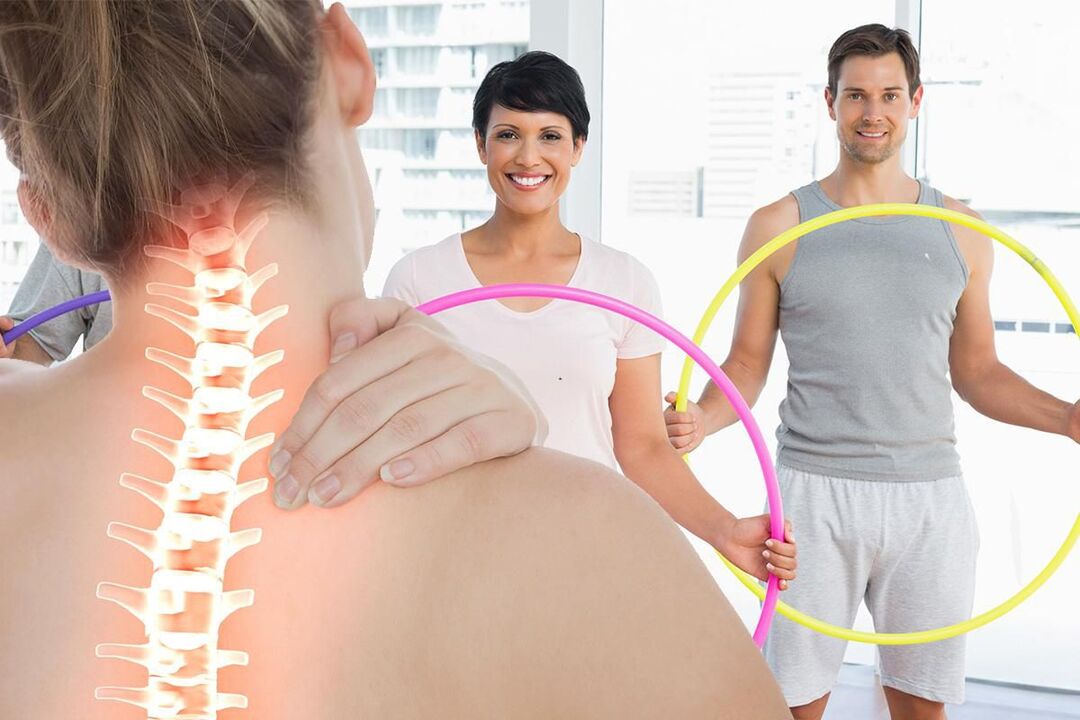
In the early stages of the development of the disease, it is often enough to adjust your lifestyle, undergo exercise therapy and consult a chiropractor.In more advanced cases, drug treatment and physiotherapy are necessarily prescribed.
Never resort to self-medication with dubious means, self-prescription of anti-inflammatories, as well as dubious "healers" who position themselves on the Internet: you can lose not only time, money, but also the remains of your health.
Drug therapy
For osteochondrosis, a complex of drugs is prescribed to reduce pain, eliminate inflammation and reflex muscle spasms, improve nerve conduction and activate the processes of tissue regeneration of the intervertebral discs.
Therefore, patients are prescribed:
- NSAIDs – help reduce pain and have an anti-inflammatory effect;
- corticosteroids – exhibit potent anti-inflammatory properties;
- muscle relaxants – eliminate muscle spasms, which helps reduce back pain;
- B vitamins – improve the functioning of the nervous system in general and the conduction of nerve impulses along individual nerves in particular;
- vitamin D is a remedy responsible for the condition of bone tissue, as well as higher brain functions, such as memory, attention, speech;
- chondroprotectors – nourish the intervertebral discs with the compounds necessary to build new fibers of the nucleus pulposus;
- psychotropic medications – increase the effectiveness of nonsteroidal anti-inflammatories and muscle relaxants;
- vascular drugs - improve blood circulation in the tissues surrounding the spine, which ensures a more active supply of nutrients and oxygen to the intervertebral discs;
- Anticonvulsants – used in rare cases to relieve very severe spasms.
In cases of very severe pain, which most often indicates complications, patients can undergo back blocks, which provide immediate effect.Sometimes corticosteroid hormones are added to the solution to effect the blockade.This further leads to a pronounced anti-inflammatory effect.
Blockages are carried out in conditions of absolute sterility, which can only be carried out in specialized medical institutions.At the same time, they require special knowledge and skills, so only a highly qualified health worker can competently cope with this task.Otherwise, there is a high risk of infection or damage to the nerve fiber, which will lead to the development of serious complications.
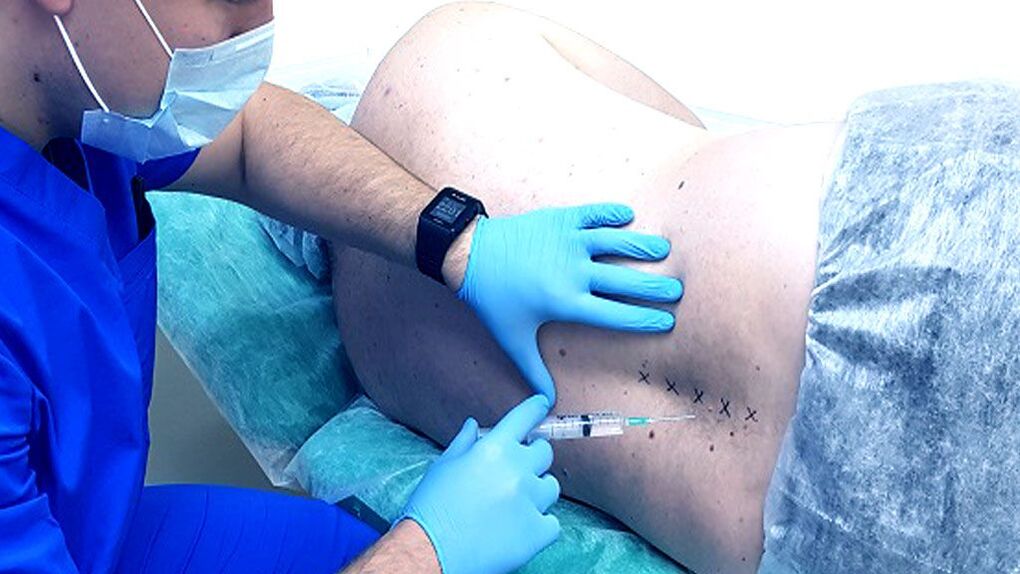
During the blockade, injections are usually given on both sides of the spine, in the area where the nerves responsible for pain are located.There are several techniques for performing them, among which the specific one is selected individually by the doctor.
But it is advisable to carry out blocking no more than 4 times a year.Since with osteochondrosis attacks of acute, aching pain occur much more often, it is appropriate, first of all, to direct efforts to eliminate the causes of their occurrence, that is, the degenerative-dystrophic process in the joint itself.
Manual therapy
Manual therapy sessions are prescribed outside the period of exacerbation of osteochondrosis.They play one of the main roles in the treatment of the disease, since the competent use of manual techniques on the spine and surrounding tissues helps not only to stop the progression of the pathological process in the intervertebral discs, but also to create the most favorable conditions for their restoration.
In addition, certain techniques can also have a positive effect on the functioning of internal organs.For example, one of the methods aims, by normalizing the position of each vertebra, to eliminate pressure on the spinal roots, blood vessels and spinal membranes and thus restore the normal connection of the organ with the nervous system.This allows you to eliminate the hidden causes of the development of the above diseases of the heart, bronchi, lungs, kidneys, gastrointestinal tract and reproductive system and leads to complete recovery.
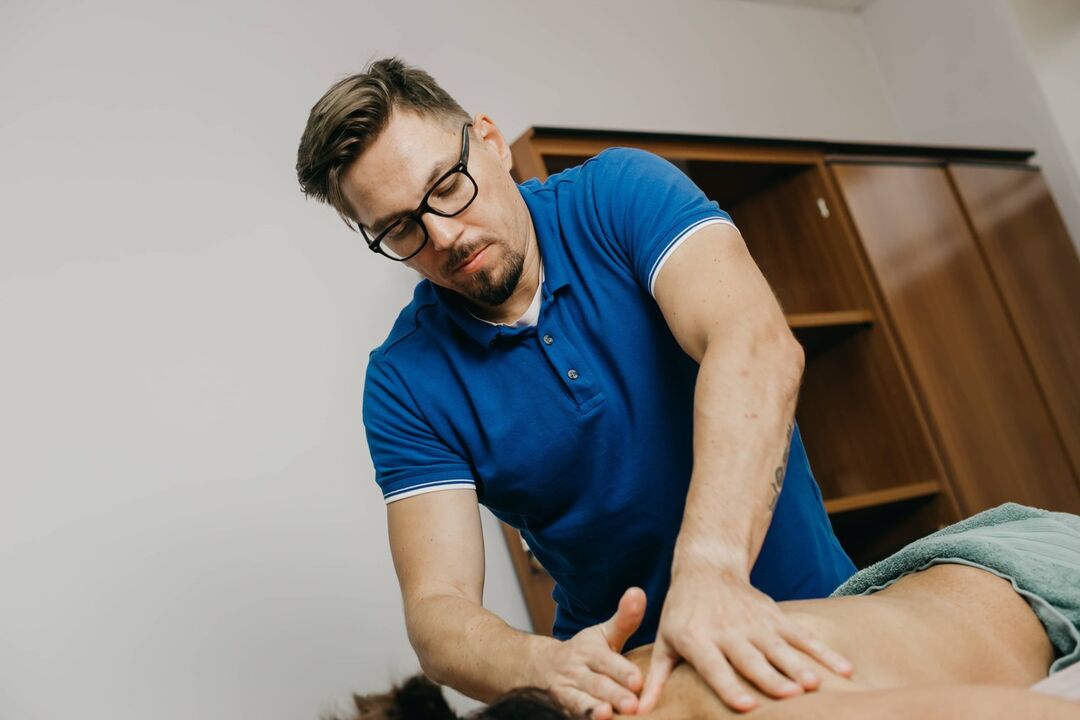
Thanks to the precise effect of the jewelry on the spine, not only is blood circulation activated and metabolism accelerated, as with a classic therapeutic massage, but natural self-healing mechanisms are also launched.Elimination of spinal curvatures, incorrect position of the vertebrae and other pathological changes in the spine through manual therapy can further strengthen the immune system, improve general well-being and significantly improve the quality of life.
Positive changes can be noticed after the first session, and in the future their severity will only increase.
Physiotherapy
Physiotherapeutic procedures increase the effectiveness of all other methods of treating osteochondrosis and help reduce pain.Most often used:
- electrophoresis - the use of electric current to ensure the penetration of anesthetics, anti-inflammatory drugs and other agents directly into the site of inflammation, allowing you to quickly achieve a pronounced therapeutic effect;
- Ultrasound therapy - the effect of ultrasound provides an analgesic effect, improves the intensity of metabolic processes in the zone of influence and creates the prerequisites for high-quality restoration of thinned intervertebral discs;
- tension therapy – consists of stretching and massaging the spine on a special ribbed mattress, which activates blood circulation and increases muscle tone;
- traction therapy or spinal traction – is carried out using special devices that create a tensile load on the spine, which leads to an increase in the distance between the vertebrae and a sharp decrease in pressure on the worn intervertebral disc, which allows it to recover more actively.
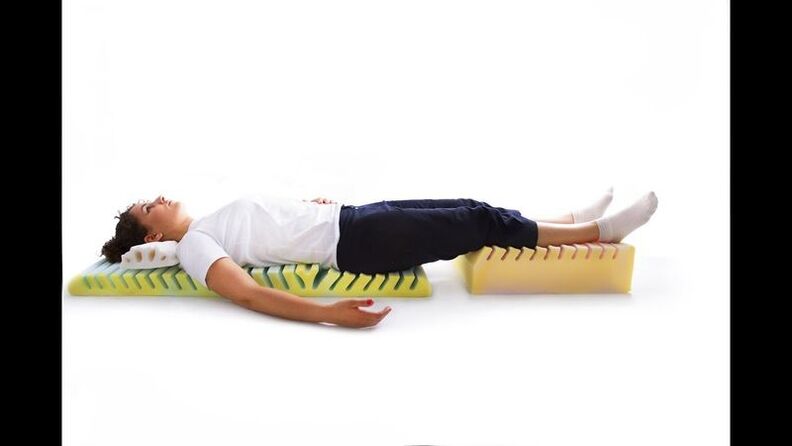
All procedures are prescribed in courses of 10-15 sessions.When choosing them, they take into account not only the condition of the intervertebral discs, but also the presence of concomitant diseases, since in some of them certain physical effects are contraindicated.
Exercise therapy
Therapeutic exercises for osteochondrosis play an important role, because correctly selected exercises for damaging different parts of the spine can help form a strong muscle corset while eliminating increased muscle tone.This will provide good support to the spine and stop the progression of the degenerative process of the intervertebral discs.In addition, exercise therapy helps to activate blood circulation and increase the intensity of metabolic processes.
Developing a physiotherapy program is the task of a rehabilitation doctor.Depending on the severity of the spinal injury, the characteristics of the patient's physical development, his age and other factors, he will create an optimal set of exercises, the implementation of which will create an optimal load on the muscles and spine.
The first courses should be carried out under the supervision of a doctor.Once the patient has learned to perform each exercise correctly, he or she is allowed to continue practicing at home.It is important to avoid any sudden movements.All exercises are performed daily slowly and smoothly, and the load increases gradually.But the appearance of pain during exercise is a good reason to refuse to perform the exercise that caused it.

Prevention
It is much easier to prevent the development of a disease than to deal with its consequences later.Since osteochondrosis can occur sooner or later in everyone, you need to think about possible risks as early as possible and do everything possible to avoid it.Therefore, each person must respect the following recommendations:
- avoid physical inactivity, exercise regularly, swim, and during sedentary work take regular breaks to warm up;
- pay attention to your posture when walking or sitting;
- purchase a high-quality orthopedic mattress and pillow;
- follow the correct technique for lifting weights: with a straight back and bent knees;
- replace casual shoes with more comfortable ones and leave dress shoes for special occasions;
- eat right so that the body does not experience nutritional deficiencies and the weight remains within normal limits.
There is only one way to avoid the appearance and manifestation of symptoms of osteochondrosis: to start taking care of yourself and your health.Since osteochondrosis is not just a disease, but a complex of musculo-tonic and neurodystrophic changes, which are the body's response to physical inactivity, chronic static tension of the spinal muscles, environmental situation and chronic neurosis, especially common among city dwellers, swimming in the pool and stretching programs, including yoga.
So, osteochondrosis is a very common disease, but by paying close attention to your own health, you can effectively fight it at any age.But ignoring the problem will not lead to anything good and will sooner or later force the patient to lie on the operating table.
























